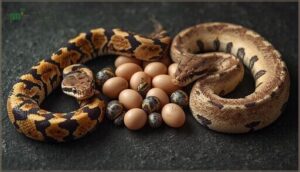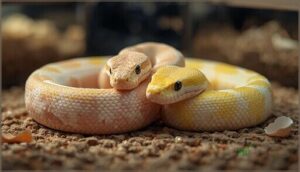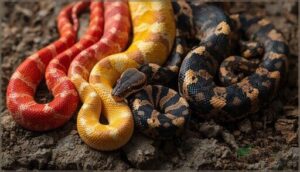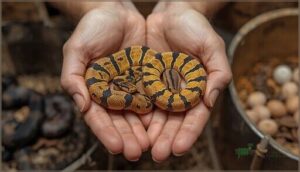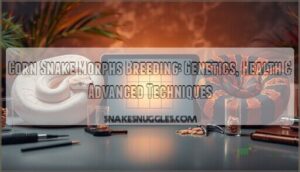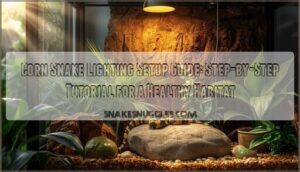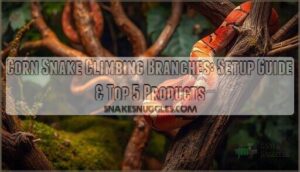This site is supported by our readers. We may earn a commission, at no cost to you, if you purchase through links.
If you’ve ever browsed corn snake listings, you’ve probably seen the word “het” pop up alongside names like Snow or Tessera. It’s easy to get lost in the genetics jargon, especially when two snakes with the same parents can look completely different.
That’s the puzzle at the heart of corn snake genetics—visual morphs flaunt their colors, while hets quietly carry hidden potential. Understanding how alleles and inheritance shape these outcomes isn’t just trivia; it’s the key to making informed breeding choices and predicting future hatchlings.
Let’s unravel what sets a visual morph apart from a het, and why it matters for every keeper.
Table Of Contents
- Key Takeaways
- Key Genetics Terms in Corn Snakes
- Visual Versus Het: What’s The Difference?
- Inheritance Patterns and Breeding Outcomes
- Common Corn Snake Morphs and Their Genetics
- Practical Considerations for Breeders
- Frequently Asked Questions (FAQs)
- What phenotypic potentials are possible for a corn snake mutation?
- How do snake genes affect coloration and pattern?
- What is the value of a tessera-type corn snake?
- Can a tessera homozygote mate with a corn snake?
- How do snakes interact with each other?
- Could a snake be born in the wild?
- Can visual morphs affect corn snake behavior?
- Are het corn snakes more expensive than wild-types?
- What role do environmental factors play in morph expression?
- How do visual and het genetics impact lifespan?
- Conclusion
Key Takeaways
- Visual morph corn snakes show their unique colors and patterns because they have specific gene mutations that are easily seen, while hets carry hidden genes that only show up in future generations.
- Dominant morphs are easy to spot with just one allele, but recessive morphs need two matching alleles to appear, making het snakes look like wild types but still valuable for breeding.
- Using Punnett squares helps you predict the chances of getting visual morphs, hets, or normal offspring, with het x het pairings giving a 25% chance for visual morphs.
- Responsible breeding means balancing the desire for striking morphs with the health and welfare of the snakes, since some genetic combinations can increase risks for disorders or reduced vitality.
Key Genetics Terms in Corn Snakes
Before you can make sense of corn snake breeding or morphs, it helps to know a few key genetics terms. Understanding the basics will make the rest of this guide much easier to follow.
Let’s take a quick look at the main concepts you need to know next.
Genotype Vs. Phenotype
When you dive into corn snake genetics, you’ll hear “genotype” and “phenotype” tossed around a lot. Genotype is all about a snake’s specific alleles—you could call it its genetic recipe. What you actually see—the color, the pattern, the scale shine—is the phenotype, shaped by genetic expression and mutation mapping against that wild-type baseline. This is largely due to the effects of the CLCN2 gene.
Morph, Phase, and Locality Explained
Once you get the hang of genotype and phenotype, you’ll start hearing morph, phase, and locality—each tells a different part of the corn snake story. A morph points to specific, heritable color or pattern changes; phase means a naturally occurring regional look; locality focuses on a snake’s geographic roots.
Understanding these distinctions sharpens your eye for distinguishing traits and evolutionary context. Corn snakes have a multitude of variations, with over 800 different morphs due to selective breeding.
Alleles, Zygosity, and “Het” Definitions
Now, let’s talk about the building blocks—alleles, zygosity, and “het.” Every corn snake’s appearance starts with allele combinations. If both alleles match (homozygous), you’ll see strong trait expression. Heterozygous traits, or “hets,” hide beneath the surface, waiting for the right pairing. Zygosity confirmation matters for breeders chasing visual hets and predicting phenotypes.
- Allele combinations shape morphs
- Homozygous expression reveals recessive traits
- Heterozygous het snakes carry hidden genes
- Visual hets sometimes mimic morphs
- Zygosity confirmation guides breeding decisions
Visual Versus Het: What’s The Difference?
Regarding corn snake genetics, understanding the difference between visual morphs and hets is key. Each type brings its own set of traits and breeding possibilities.
Let’s look at how these differences show up in your snakes.
How Visual Morphs Are Expressed
Ever wonder why some corn snakes flaunt striking colors and patterns? Visual morphs show up when gene mutations directly change pigment cells and protein expression, shaping their unique phenotypes.
Developmental mechanisms during growth set these visual characteristics in stone. The frequency of each morph in a population depends on gene expression and the specific coloration mutations present in breeding lines.
Identifying Heterozygous (“Het”) Snakes
How can you spot a Het corn snake when its phenotype looks just like a wild type? Most recessive hets hide their genetic secrets, so you’ll need more than your eyes. Here are five ways breeders tackle the challenge:
- Visual Het Indicators
- Genetic Testing Methods
- Breeding Strategies
- Market Value
- Ethical Concerns
Recessive Vs. Dominant Morph Presentation
Although both recessive and dominant morphs shape a corn snake’s appearance, their allele expression leads to very different morph visibility and breeding outcomes. Dominant morphs show their phenotype with just one allele, making phenotype identification straightforward.
Recessive morphs, however, require two matching alleles, so only homozygous snakes display the visual morph—hidden genetic interactions often complicate genotype assessment.
Inheritance Patterns and Breeding Outcomes
Understanding how traits get passed down in corn snakes can help you plan your breeding projects with confidence. The basics of genetics play a big role in predicting what your hatchlings might look like.
Here’s what you need to know about the key patterns and outcomes you’ll see.
Mendelian Genetics in Corn Snakes
Imagine predicting a corn snake’s future look with a simple chart—Mendelian genetics makes this possible. By understanding how genes and alleles interact, you can use genotype prediction to forecast phenotype ratios.
Punnett Square usage reveals how inheritance works, even with double-gene crosses. Recombination events add complexity, but the basics remain your roadmap in corn snake genetics.
Using Punnett Squares for Morph Prediction
Think of a Punnett square as your genetic crystal ball—mapping out genotype probabilities and phenotype ratios for each possible offspring.
Here’s how you use it:
- List parent genotypes for the trait.
- Combine alleles in the square’s boxes.
- Count visual morphs, hets, and normals.
- Factor in clutch variation and complex traits with software calculators.
Percentage “Het” and Breeding Probability
Ever wonder how breeders predict which corn snake offspring will carry hidden genes? Het inheritance relies on probability, not guesswork. For example, breeding two hets gives you a 25% chance for visual outcomes, but probability dilution creeps in with each generation. Use Punnett squares to guide your breeding strategies and track generational implications.
| Parent Type | Offspring Type | Probability |
|---|---|---|
| Het x Het | Visual | 25% |
| Het x Het | Het | 50% |
| Het x Het | Normal | 25% |
Common Corn Snake Morphs and Their Genetics
Corn snake morphs come in a wide range of patterns and colors, each with its own genetic story. Understanding how these morphs are inherited can help you choose the right pairing for your breeding goals.
Let’s look at some of the most common morphs and how their genetics work.
Popular Visual Morphs (e.g., Tessera, Snow)
Did you know Tessera inheritance guarantees every baby shows the morph when bred to a normal corn snake? Snow genetics work differently, needing two recessive alleles for visual identification.
These corn snake morphs—Tessera and Snow—stand out thanks to their distinct color morphs and patterns. Their phenotypes drive morph prevalence and shape breeding outcomes, making them favorites among visual morph characteristics.
Double Recessive and Designer Morphs
While Tessera and Snow grab attention, double recessive morphs like Butter and Blizzard push genetic combos further. You’ll need both parents to carry recessive genes—double hets—to see these rare designer morphs.
Genetic testing confirms traits, supporting breeding ethics and market value. Morph rarity keeps collectors interested, especially when new designer morphs surface with unique patterns and stable genetic combinations.
Morph Combinations and Polygenic Traits
Designer morphs are just the beginning—compound morph breeding can mix five or more traits, with polygenic trait inheritance adding even more layers. Visual outcome predictability gets tricky, since polygenic traits like Salmon or Halo depend on multiple gene effects. You’ll want solid breeding record analysis to track:
- Genetic combinations
- Polygenic traits
- Phenotype variations
- Designer hybrid limitations
Practical Considerations for Breeders
When you’re planning to breed corn snakes, there’s more to think about than just genetics. Your choices as a breeder can impact both the health and appearance of future hatchlings. Let’s look at some practical options that can help set you up for success.
Selecting Visual and Het Parents
When you’re planning a clutch, genetic selection is key. Visual pairing guarantees every hatchling shows the phenotype, while het pairing offers a mix—half visual, half heterozygous.
Dominant alleles make things simple, but recessive alleles require careful tracking of each parent’s genotype and allele status. That’s why keeping detailed records helps you predict outcomes and avoid surprises.
Ethical and Health Implications of Morph Breeding
When you’re selecting parents for morph breeding, it’s easy to focus on phenotype and genetic traits. But selective breeding can bring morph-linked disorders, inbreeding depression, and unexpected captivity effects. You’ll want to watch for:
- Cardiac risks in some morphs
- Behavioral correlates tied to genetic mutations
- Increased health issues with reduced genetic diversity
Balance appearance with long-term welfare.
Prioritize the long-term health and welfare of corn snakes, not just their visual appeal, when breeding for morphs
Frequently Asked Questions (FAQs)
What phenotypic potentials are possible for a corn snake mutation?
Phenotypic potentials in corn snakes range from striking color patterns to unique visual characteristics, shaped by morph combinations, polygenic traits, recombination effects, and new mutations.
Smart breeding strategies enable diverse genetic expression and reveal fresh, unexpected morphs.
How do snake genes affect coloration and pattern?
Colorful corn snakes captivate with patterns shaped by CLCN2 variants, recessive morphs, and dominant alleles. Het status hides color changes, while polygenic influence subtly shifts pigments. These genetic twists define corn snake coloration and pattern variations.
What is the value of a tessera-type corn snake?
The Tessera market price averages $100 for a single-gene visual morph, with Tessera combo value reaching $155–$
Homozygous Tessera rarity and unique pattern mutation impact drive steady Tessera sales trends, reflecting strong interest in visual morph characteristics.
Can a tessera homozygote mate with a corn snake?
A homozygous Tessera can mate with any corn snake, showing full genetic compatibility and homozygous viability. Breeding outcomes produce 100% Tessera-patterned offspring, making this pairing straightforward in corn snake genetics terminology and ethical considerations.
How do snakes interact with each other?
It’s no coincidence that snake social structures mirror those of higher animals—corn snakes and others use chemical signals, body language, and territoriality patterns to interact.
Seasonal behavior shapes encounters, with communication methods weaving together health, breeding, and genetics.
Could a snake be born in the wild?
Absolutely—a snake can be born in the wild. Wild-born documentation shows hatchlings emerge naturally, displaying genetic variation and atypical phenotypes.
Wild morph origin often comes from natural mutation rates, though hatchling survival rates depend on wild survival conditions.
Can visual morphs affect corn snake behavior?
Visual morphs in corn snakes don’t change core behavior or temperament. Studies show no genetic link between morphs and learning differences or sensory perception, though amelanistic phenotypes face higher predation vulnerability due to reduced environmental adaptation and camouflage.
Are het corn snakes more expensive than wild-types?
If you’ve ever wondered why a plain-looking snake costs more than its wild sibling, blame het price factors.
Heterozygous corn snakes fetch higher prices, thanks to morph rarity, supply and demand, breeder reputation, and market trends.
What role do environmental factors play in morph expression?
Environmental factors like temperature effects, humidity impact, nutritional influence, and light exposure can reshape gene expression and phenotype in corn snakes.
Epigenetic changes triggered during development often alter coloration, leading to unexpected shifts in morph appearance and vibrancy.
How do visual and het genetics impact lifespan?
Morph lifespan data shows no clear link between phenotype or genotype and reduced longevity; het health risks are minimal. Breeding practices impact outcomes more than genetic inheritance.
Environmental factors, not heterozygous status or genetic defect links, drive snake genetics lifespan.
Conclusion
Visual morphs dazzle with color and pattern, while hets quietly hold the blueprint for future surprises—corn snake genetics visual versus het is a study in contrasts.
When you pair the showy with the subtle, you’re not just breeding snakes; you’re shaping possibilities. Each hatchling is a living demonstration of the choices you make.
Understanding these genetic dynamics allows you to breed responsibly, anticipate outcomes, and appreciate the hidden stories woven into every scale and stripe.
- https://community.morphmarket.com/t/corn-snake-genetics-question/21649
- https://omgsnakes.com/post/625227307315068928/could-you-explain-to-me-the-diffrence-between-the
- https://cornsnake.net/blogs/stories/history-of-the-tessera-mutation
- https://www.cornsnakes.com/forums/threads/genetics-tutorial.83372/
- https://www.youtube.com/watch?v=9r_38QOvZ7k



